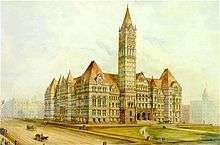Great Fire of Toronto (1904)
Part of a series on the |
||||||||||||||||
|---|---|---|---|---|---|---|---|---|---|---|---|---|---|---|---|---|
| History of Toronto | ||||||||||||||||
 | ||||||||||||||||
| History | ||||||||||||||||
|
||||||||||||||||
| Events | ||||||||||||||||
|
||||||||||||||||
| Other | ||||||||||||||||
|
| ||||||||||||||||
The Great Fire of Toronto of 1904 was a great fire that destroyed a large section of Downtown Toronto, Ontario, Canada on April 19, 1904. It was the second of such fires for the city in its then short history.
Incident


The fire was first spotted at 8:04 p.m., on April 19, 1904, by a Toronto Police constable on his regular street patrol.[1] The flames were rising from the elevator shaft of the E & S Currie Limited's neck wear factory at 58 Wellington Street West, just west of Bay Street (now TD Bank Tower).[1][2] The factory was situated in the centre of a large industrial and commercial area. The exact cause of the fire was never determined, but a faulty heating stove or an electrical problem is suspected.[3]
With 17 fire halls alerted, two engine companies and one hose company, the fire took nine hours to get under control. The glow of the fire could be seen for kilometres in all directions. Firefighters from cities as far away as Hamilton, Ontario and Buffalo came to Toronto's aid. The temperature that night was approximately −4 °C (25 °F) with winds at 48 kilometres per hour (30 mph) and snow flurries.
.jpg)
The fire destroyed more than 100 buildings.[4] Damage on Wellington Street West and Yonge Street was limited because one of the buildings, the Kilgour Brothers factory, had a sprinkler system fed by water tanks on the roof, preventing the fire from spreading in that direction.[5]
The fire claimed one victim, John Croft, who was an explosive expert clearing the ruins from the fire.[6] It caused C$10,387,000 in damage[7][8] and put five thousand people out of work; at the time the city had 200,000 inhabitants. As a result of the fire, more stringent safety laws were introduced and an expansion of the city's fire department was undertaken.[8]
A few buildings nearby survived including the Bank of Montreal building at Yonge and Front Streets, Customs House and their warehouse (demolished in 1919), Toronto Evening Telegram Building.
Legacy
The fire remains the largest fire ever to have occurred in Toronto. A previous fire on April 7, 1849, consumed many city blocks when the city was much smaller and many more structures were wooden.
Call Box 12, which was used to sound the alarm, is the name for the volunteer canteen truck supporting Toronto Fire Services today.
Toronto Fire Services Public Education Centre and Museum at Station 233 has a model displaying the area of the fire.
A 1904 film, The Great Fire of Toronto, created by George Scott & Co. about the event, was the first to be shot in Toronto.[9]
Part of the area cleared by the fire became the site of Union Station, built during the following decade.[10]
Gallery
See also
| Wikimedia Commons has media related to Toronto Fire of 1904. |
- Toronto Fire Services
- Buffalo Fire Department
- List of historic Toronto fire stations
- List of historic fires
- Great Fire of London – 1666
- Great Fire of Pittsburgh - 1845
- Great Fire of Toronto (1849)
References
- 1 2 Flack, Derek (April 19, 2011). "The great Toronto fire of 1904". BlogTO. Toronto. Archived from the original on October 8, 2013. Retrieved October 8, 2013.
- ↑ Neil Carlson (2008). Night+Day Toronto. ASDavis Media Group. pp. 11–. ISBN 978-1-934724-02-6.
- ↑ Mayers, Adam (August 5, 2008). "The Great Fire of 1904". The Toronto Star. Toronto. Archived from the original on October 8, 2013. Retrieved October 8, 2013.
- ↑ Oeter Morris (6 August 1992). Embattled Shadows: A History of Canadian Cinema, 1895-1939. McGill-Queen's Press - MQUP. pp. 38–. ISBN 978-0-7735-6072-7.
- ↑ Mike Filey (24 October 2015). Mike Filey's Toronto Sketches, Books 10–12. Dundurn. pp. 265–. ISBN 978-1-4597-3545-3.
- ↑ Mike Filey (1 June 1999). Mount Pleasant Cemetery: An Illustrated Guide: Second Edition, Revised and Expanded. Dundurn. pp. 74–. ISBN 978-1-4597-1310-9.
- ↑ "Oil Fire Menaces Toronto". The Evening Citizen. Ottawa. February 12, 1948. p. 1. Retrieved December 5, 2014.
- 1 2 University of Toronto. PediaPress. pp. 47–. GGKEY:PB3JJ92XTJL.
- ↑ Wyndham Wise (1 February 2015). Take One's Essential Guide to Canadian Film. University of Toronto Press, Scholarly Publishing Division. pp. 2000–. ISBN 978-1-4426-5620-8.
- ↑ Mike Filey (2001). A Toronto Album: Glimpses of the City that was. Dundurn. pp. 92–. ISBN 978-0-88882-242-0.
Bibliography
- Lasiuk, Jon; Friebe, Marla (2003). A History of the Toronto Fire Services 1874-2002. Toronto: Toronto Fire Department. ISBN 978-0-9737066-0-4.
External links
- Silent footage of a wagon responding to the alarm, buildings on fire, and demolition of damaged buildings
- Pictures of the fire's aftermath from the City of Toronto Archives site
- The Great Toronto Fire, the Archives of Ontario remembers this significant event in the city's history
- Croft Street, Toronto







.jpg)